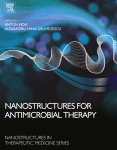

Most ebook files are in PDF format, so you can easily read them using various software such as Foxit Reader or directly on the Google Chrome browser.
Some ebook files are released by publishers in other formats such as .awz, .mobi, .epub, .fb2, etc. You may need to install specific software to read these formats on mobile/PC, such as Calibre.
Please read the tutorial at this link: https://ebookbell.com/faq
We offer FREE conversion to the popular formats you request; however, this may take some time. Therefore, right after payment, please email us, and we will try to provide the service as quickly as possible.
For some exceptional file formats or broken links (if any), please refrain from opening any disputes. Instead, email us first, and we will try to assist within a maximum of 6 hours.
EbookBell Team

4.7
96 reviewsNanostructures for Antimicrobial Therapy discusses the pros and cons of the use of nanostructured materials in the prevention and eradication of infections, highlighting the efficient microbicidal effect of nanoparticles against antibiotic-resistant pathogens and biofilms.
Conventional antibiotics are becoming ineffective towards microorganisms due to their widespread and often inappropriate use. As a result, the development of antibiotic resistance in microorganisms is increasingly being reported. New approaches are needed to confront the rising issues related to infectious diseases. The merging of biomaterials, such as chitosan, carrageenan, gelatin, poly (lactic-co-glycolic acid) with nanotechnology provides a promising platform for antimicrobial therapy as it provides a controlled way to target cells and induce the desired response without the adverse effects common to many traditional treatments.
Nanoparticles represent one of the most promising therapeutic treatments to the problem caused by infectious micro-organisms resistant to traditional therapies. This volume discusses this promise in detail, and also discusses what challenges the greater use of nanoparticles might pose to medical professionals. The unique physiochemical properties of nanoparticles, combined with their growth inhibitory capacity against microbes has led to the upsurge in the research on nanoparticles as antimicrobials. The importance of bactericidal nanobiomaterials study will likely increase as development of resistant strains of bacteria against most potent antibiotics continues.